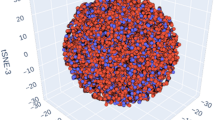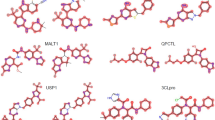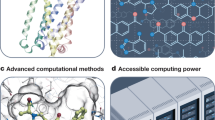Abstract
Molecules with bioactivity towards G protein-coupled receptors represent a subset of the vast space of small drug-like molecules. Here, we compare machine learning models, including dilated graph convolutional networks, that conduct binary classification to quickly identify molecules with activity towards G protein-coupled receptors. The models are trained and validated using a large set of over 600,000 active, inactive, and decoy compounds. The best performing machine learning model, dubbed GPCRLigNet, was a surprisingly simple feedforward dense neural network mapping from Morgan fingerprints to activity. Incorporation of GPCRLigNet into a high-throughput virtual screening workflow is demonstrated with molecular docking towards a particular G protein-coupled receptor, the pituitary adenylate cyclase-activating polypeptide receptor type 1. Through rigorous comparison of docking scores for molecules selected with and without using GPCRLigNet, we demonstrate an enrichment of potentially potent molecules using GPCRLigNet. This work provides a proof of principle that GPCRLigNet can effectively hone the chemical search space towards ligands with G protein-coupled receptor activity.







Similar content being viewed by others
Data and Software availability
The Python scripts for generating the training and validation datasets, building, and training machine learning models, and evaluating them are all available on GitHub https://github.com/jrem-chem/GPCRLigNet.git. In addition, the datasets themselves and indexes used for training and validation are provided along with the data and Python scripts to produce the figures in the paper.
References
Sriram K, Insel PAG Protein-Coupled Receptors as Targets for Approved Drugs: How Many Targets and How Many Drugs?Mol Pharmacol2018, 93 (4),251. https://doi.org/10.1124/mol.117.111062
Kratochwil NA, Malherbe P, Lindemann L, Ebeling M, Hoener MC, Mühlemann A, Porter RHP, Stahl M, Gerber PR An Automated System for the Analysis of G Protein-Coupled Receptor Transmembrane Binding Pockets: Alignment, Receptor-Based Pharmacophores, and Their Application.J. Chem. Inf. Model2005, 45 (5),1324–1336. https://doi.org/10.1021/ci050221u
Porter HP, Steward R, Kolczewski L, Panousis SG, Narquizian C, Hertel R, Grether C, Dehmlow U, Winnig H, Slack MP, Kratochwil JA, Malherbe N, Martin PE, Guba R, Green WG, Christ LD, Lindemann A, Hoener LC, Gatti-McArthur M S. G Protein-Coupled Receptor Transmembrane Binding Pockets and Their Applications in GPCR Research and Drug Discovery: A Survey.Current Topics in Medicinal Chemistry2011, 11 (15),1902–1924. https://doi.org/10.2174/156802611796391267
Mckay K, Hamilton NB, Remington JM, Schneebeli ST, Li J (2022) Essential Dynamics Ensemble Docking for Structure-Based GPCR Drug Discovery. Front. Mol. Bioscihttps://doi.org/fmolb.879212
Balakin KV, Tkachenko SE, Lang SA, Okun I, Ivashchenko AA, Savchuk NP Property-Based Design of GPCR-Targeted Library.J. Chem. Inf. Comput. Sci2002, 42 (6),1332–1342. https://doi.org/10.1021/ci025538y
Balakin KV, Lang SA, Skorenko AV, Tkachenko SE, Ivashchenko AA, Savchuk NP Structure-Based versus Property-Based Approaches in the Design of G-Protein-Coupled Receptor-Targeted Libraries.J. Chem. Inf. Comput. Sci2003, 43 (5),1553–1562. https://doi.org/10.1021/ci034114g
von Korff M, Steger M GPCR-Tailored Pharmacophore Pattern Recognition of Small Molecular Ligands.J. Chem. Inf. Comput. Sci2004, 44 (3),1137–1147. https://doi.org/10.1021/ci0303013
Lamb ML, Bradley EK, Beaton G, Bondy SS, Castellino AJ, Gibbons PA, Suto MJ, Grootenhuis PD J. Design of a Gene Family Screening Library Targeting G-Protein Coupled Receptors.Journal of Molecular Graphics and Modelling2004, 23 (1),15–21. https://doi.org/10.1016/j.jmgm.2004.03.001
Givehchi A, Schneider G Multi-Space Classification for Predicting GPCR-Ligands.Molecular Diversity2005, 9 (4),371–383. https://doi.org/10.1007/s11030-005-6293-4
Kelemen ÁA, Ferenczy GG, Keserű GM A Desirability Function-Based Scoring Scheme for Selecting Fragment-like Class A Aminergic GPCR Ligands.Journal of Computer-Aided Molecular Design2015, 29 (1),59–66. https://doi.org/10.1007/s10822-014-9804-5
van der Horst E, Okuno Y, Bender A, IJzerman AP Substructure Mining of GPCR Ligands Reveals Activity-Class Specific Functional Groups in an Unbiased Manner.J. Chem. Inf. Model2009, 49 (2),348–360. https://doi.org/10.1021/ci8003896
Seo S, Choi J, Ahn SK, Kim KW, Kim J, Choi J, Kim J, Ahn J Prediction of GPCR-Ligand Binding Using Machine Learning Algorithms. Comput Math Methods Med 2018, 2018, 6565241–6565241. https://doi.org/10.1155/2018/6565241
Raschka S, Kaufman B Machine Learning and AI-Based Approaches for Bioactive Ligand Discovery and GPCR-Ligand Recognition.Methods2020, 180,89–110. https://doi.org/10.1016/j.ymeth.2020.06.016
Chan WKB, Zhang H, Yang J, Brender JR, Hur J, Özgür A, Zhang YGLASS A Comprehensive Database for Experimentally Validated GPCR-Ligand Associations.Bioinformatics2015, 31 (18),3035–3042. https://doi.org/10.1093/bioinformatics/btv302
Mysinger MM, Carchia M, Irwin JJ, Shoichet BK Directory of Useful Decoys, Enhanced (DUD-E): Better Ligands and Decoys for Better Benchmarking.J. Med. Chem2012, 55 (14),6582–6594. https://doi.org/10.1021/jm300687e
NCI/CADD, group. Cactus Web Server (2021) https://cactus.nci.nih.gov/
RDKit Open-Source Cheminformatics. http://www.rdkit.org
Durant JL, Leland BA, Henry DR, Nourse JG Reoptimization of MDL Keys for Use in Drug Discovery.J. Chem. Inf. Comput. Sci2002, 42 (6),1273–1280. https://doi.org/10.1021/ci010132r
Rogers D, Hahn M, Extended-Connectivity, FingerprintsJ. Chem. Inf. Model2010, 50 (5),742–754. https://doi.org/10.1021/ci100050t
Abadi M, Barham P, Chen J, Chen Z, Davis A, Dean J, Devin M, Ghemawat S, Irving G, Isard M, Kudlur M, Levenberg J, Monga R, Moore S, Murray D, Steiner B, Tucker P, Vasudevan V, Warden P, Zhang X TensorFlow:A System for Large-Scale Machine Learning. 2016
Kipf TN, Welling M Semi-Supervised Classification with Graph Convolutional Networks. CoRR 2016, abs/1609.02907
Duvenaud D, Maclaurin D, Aguilera-Iparraguirre J, G\’mez-Bombarelli R, Hirzel T, Aspuru-Guzik A ’n; Adams, R. P. Convolutional Networks on Graphs for Learning Molecular Fingerprints. Nips’15 2015, 2224–2232
Kearnes S, McCloskey K, Berndl M, Pande V, Riley P Molecular Graph Convolutions: Moving beyond Fingerprints.Journal of computer-aided molecular design2016, 30 (8),595–608. https://doi.org/10.1007/s10822-016-9938-8
Xiong Z, Wang D, Liu X, Zhong F, Wan X, Li X, Li Z, Luo X, Chen K, Jiang H, Zheng M Pushing the Boundaries of Molecular Representation for Drug Discovery with the Graph Attention Mechanism.J. Med. Chem2020, 63 (16),8749–8760. https://doi.org/10.1021/acs.jmedchem.9b00959
Yang K, Swanson K, Jin W, Coley C, Eiden P, Gao H, Guzman-Perez A, Hopper T, Kelley B, Mathea M, Palmer A, Settels V, Jaakkola T, Jensen K, Barzilay R Analyzing Learned Molecular Representations for Property Prediction.J. Chem. Inf. Model2019, 59 (8),3370–3388. https://doi.org/10.1021/acs.jcim.9b00237
Visini R, Awale M, Reymond J-L, Fragment Database FDB-17J. Chem. Inf. Model2017, 57 (4),700–709. https://doi.org/10.1021/acs.jcim.7b00020
Lipinski CA, Lombardo F, Dominy BW, Feeney PJ Experimental and Computational Approaches to Estimate Solubility and Permeability in Drug Discovery and Development Settings.Adv Drug Deliv Rev2001, 46 (1–3),3–26. https://doi.org/10.1016/s0169-409x(00)00129-0
Veber DF, Johnson SR, Cheng H-Y, Smith BR, Ward KW, Kopple KD Molecular Properties That Influence the Oral Bioavailability of Drug Candidates.J Med Chem2002, 45 (12),2615–2623. https://doi.org/10.1021/jm020017n
Ghose AK, Viswanadhan VN, Wendoloski JJ A Knowledge-Based Approach in Designing Combinatorial or Medicinal Chemistry Libraries for Drug Discovery. 1. A Qualitative and Quantitative Characterization of Known Drug Databases.J Comb Chem1999, 1 (1),55–68. https://doi.org/10.1021/cc9800071
Bickerton GR, Paolini GV, Besnard J, Muresan S, Hopkins AL Quantifying the Chemical Beauty of Drugs.Nature Chemistry2012, 4 (2),90–98. https://doi.org/10.1038/nchem.1243
Heifetz A, Chudyk EI, Gleave L, Aldeghi M, Cherezov V, Fedorov DG, Biggin PC, Bodkin MJ The Fragment Molecular Orbital Method Reveals New Insight into the Chemical Nature of GPCR–Ligand Interactions.J. Chem. Inf. Model2016, 56 (1),159–172. https://doi.org/10.1021/acs.jcim.5b00644
Morao I, Fedorov DG, Robinson R, Southey M, Townsend-Nicholson A, Bodkin MJ, Heifetz A Rapid and Accurate Assessment of GPCR–Ligand Interactions Using the Fragment Molecular Orbital-Based Density-Functional Tight-Binding Method.Journal of Computational Chemistry2017, 38 (23),1987–1990. https://doi.org/10.1002/jcc.24850
Chudyk EI, Sarrat L, Aldeghi M, Fedorov DG, Bodkin MJ, James T, Southey M, Robinson R, Morao I, Heifetz A (2018) Exploring GPCR-Ligand Interactions with the Fragment Molecular Orbital (FMO) Method. In Computational Methods for GPCR Drug Discovery; Heifetz, A., Ed.; Springer New York: New York, NY, ; pp 179–195. https://doi.org/10.1007/978-1-4939-7465-8_8
Vistoli G, Pedretti A, Testa B Assessing Drug-Likeness–What Are We Missing?Drug Discov Today2008, 13 (7–8),285–294. https://doi.org/10.1016/j.drudis.2007.11.007
Liao C, de Molliens MP, Schneebeli ST, Brewer M, Song G, Chatenet D, Braas KM, May V, Li J Targeting the PAC1 Receptor for Neurological and Metabolic Disorders.Curr Top Med Chem2019, 19 (16),1399–1417. https://doi.org/10.2174/1568026619666190709092647
Liao C, Remington JM, May V, Li J Molecular Basis of Class B GPCR Selectivity for the Neuropeptides PACAP and VIP. Frontiers in Molecular Biosciences 2021, 8
Beebe X, Darczak D, Davis-Taber RA, Uchic ME, Scott VE, Jarvis MF, Stewart AO Discovery and SAR of Hydrazide Antagonists of the Pituitary Adenylate Cyclase-Activating Polypeptide (PACAP) Receptor Type 1 (PAC1-R).Bioorganic & Medicinal Chemistry Letters2008, 18 (6),2162–2166. https://doi.org/10.1016/j.bmcl.2008.01.052
Acknowledgements
The work was mainly supported by an NIH grant R01-GM129431 to J.L. J.B.F. was supported by an NSF award (CHE-1945394 to J.L.). S.T.S. was supported by an NIH R35 award (R35-GM147579).
Author information
Authors and Affiliations
Contributions
J.R. and J.L. wrote the main manuscript text. J.R., K.M, and N.B. prepared the figures. All authors reviewed and revised the manuscript.
Corresponding author
Ethics declarations
Competing interests
The authors declare no competing interests.
Additional information
Publisher’s Note
Springer Nature remains neutral with regard to jurisdictional claims in published maps and institutional affiliations.
Electronic supplementary material
Below is the link to the electronic supplementary material.
Rights and permissions
Springer Nature or its licensor (e.g. a society or other partner) holds exclusive rights to this article under a publishing agreement with the author(s) or other rightsholder(s); author self-archiving of the accepted manuscript version of this article is solely governed by the terms of such publishing agreement and applicable law.
About this article
Cite this article
Remington, J.M., McKay, K., Beckage, N.B. et al. GPCRLigNet: rapid screening for GPCR active ligands using machine learning. J Comput Aided Mol Des 37, 147–156 (2023). https://doi.org/10.1007/s10822-023-00497-2
Received:
Accepted:
Published:
Issue Date:
DOI: https://doi.org/10.1007/s10822-023-00497-2




